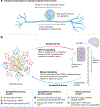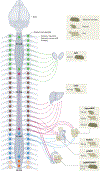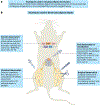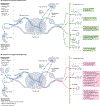The metabolic and functional roles of sensory nerves in adipose tissues
- PMID: 37709960
- PMCID: PMC12636859
- DOI: 10.1038/s42255-023-00868-x
The metabolic and functional roles of sensory nerves in adipose tissues
Abstract
Homeostatic regulation of adipose tissue is critical for the maintenance of energy balance and whole-body metabolism. The peripheral nervous system provides bidirectional neural communication between the brain and adipose tissue, thereby providing homeostatic control. Most research on adipose innervation and nerve functions has been limited to the sympathetic nerves and their neurotransmitter norepinephrine. In recent years, more work has focused on adipose sensory nerves, but the contributions of subsets of sensory nerves to metabolism and the specific roles contributed by sensory neuropeptides are still understudied. Advances in imaging of adipose innervation and newer tissue denervation techniques have confirmed that sensory nerves contribute to the regulation of adipose functions, including lipolysis and browning. Here, we summarize the historical and latest findings on the regulation, function and plasticity of adipose tissue sensory nerves that contribute to metabolically important processes such as lipolysis, vascular control and sympathetic axis cross-talk.
© 2023. Springer Nature Limited.
Conflict of interest statement
Competing interests
The authors declare no competing interests.
Figures




References
-
- Bartness T & Kay Song C Innervation of brown adipose tissue and its role in thermogenesis. Can. J. Diabetes 29, 420–428 (2005).
-
- Youngstrom TG & Bartness TJ White adipose tissue sympathetic nervous system denervation increases fat pad mass and fat cell number. Am. J. Physiol. 275, R1488–R1493 (1998). - PubMed
Publication types
MeSH terms
Grants and funding
LinkOut - more resources
Full Text Sources

